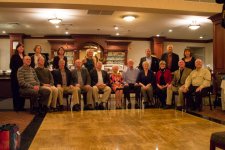The D90 does have the commander in it. Don't know about the Sony.
Three flashes is more power, and bounce can be distributed to evenly cover the group better. Keep in mind that the commander is metering the light in the center, and trying to adjust the each flash units power level to illuminate the center, even if the flash is meant to instead illuminate one side. If that is a problem, you could shift to manual flash (in commander menu, still triggered by the commander). Meaning then it is you that adjusts each power level (trial and error, by eye).
The commander trigger should not be much problem here. Rotate each flash body so that the sensor on side (by battery door) points back at commander on camera.
Another issue is that the commander probably causes subjects to blink (pictures of blinking people). FV Lock is the work around. Cameras with Commander also have FV Lock (but needs a function button to be programmed to do it). D90 camera manual is at http://support.nikonusa.com/app/answers/detail/a_id/13948
I worry that adding lots of unseen new stuff is an unreliable way to approach a big job that is already difficult. Some serious practice beforehand can only help.
Some serious practice beforehand can only help.
If using direct flash, I would combine all three of them above the camera, for power and depth of field (to minimize the shadows of one row on the one behind). If it were only one row, it would be very different, but this a a few dozen people, with no bleacher seating rows, etc. But direct flash will suffer light fall off - twice as far is 2 stops down. Lights set farther back can help that, slightly. Fewer rows, closer together, can minimize their depth spread. Repeat, there are two factors, normal focus depth of field, and also light fall off with distance.
Any group, even only three people, usually has the problem that some one of them blinks or looks funny or something unacceptable. Hard to watch all of them at once. So do take a few tries, but there will still be of few of the people not quite right.
Three flashes is more power, and bounce can be distributed to evenly cover the group better. Keep in mind that the commander is metering the light in the center, and trying to adjust the each flash units power level to illuminate the center, even if the flash is meant to instead illuminate one side. If that is a problem, you could shift to manual flash (in commander menu, still triggered by the commander). Meaning then it is you that adjusts each power level (trial and error, by eye).
The commander trigger should not be much problem here. Rotate each flash body so that the sensor on side (by battery door) points back at commander on camera.
Another issue is that the commander probably causes subjects to blink (pictures of blinking people). FV Lock is the work around. Cameras with Commander also have FV Lock (but needs a function button to be programmed to do it). D90 camera manual is at http://support.nikonusa.com/app/answers/detail/a_id/13948
I worry that adding lots of unseen new stuff is an unreliable way to approach a big job that is already difficult.
If using direct flash, I would combine all three of them above the camera, for power and depth of field (to minimize the shadows of one row on the one behind). If it were only one row, it would be very different, but this a a few dozen people, with no bleacher seating rows, etc. But direct flash will suffer light fall off - twice as far is 2 stops down. Lights set farther back can help that, slightly. Fewer rows, closer together, can minimize their depth spread. Repeat, there are two factors, normal focus depth of field, and also light fall off with distance.
Any group, even only three people, usually has the problem that some one of them blinks or looks funny or something unacceptable. Hard to watch all of them at once. So do take a few tries, but there will still be of few of the people not quite right.


